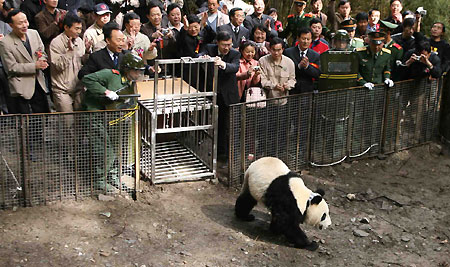WOLONG, Sichuan Province: Xiang Xiang, a four-year-old giant panda born in
captivity, took a historic step when he walked into the wild in Wolong, a
traditional habitat for the endangered species in Southwest China's Sichuan
Province.
 |
|
| Xiang Xiang, a
panda bred in captivity, wanders out of a small cage with metal bars into
the wild as dozens of people smile and clap behind a fence at Wolong, a
traditional habitat for the endangered species, in Southwest China's
Sichuan Province on Friday. Xiang Xiang became the first-ever human-raised
giant panda to be released into the wild. [newsphoto] |
|
He became the first-ever human-raised giant panda to be released into the
wild, and had to undergo three years of survival training. He will be monitored
through a global positioning device attached to a collar.
Facing his new world, the panda hesitated for a second on Friday then
wandered into bamboo groves 10 metres away.
Xiang Xiang, which means "auspicious," weighs 83 kilograms and is 1.1 metres
long.
Watching him leave, Liu Bin, who helped look after him for three years,
turned away with tears in his eyes.
"Xiang Xiang is like my child who has grown up and left the family to live
independently," said Liu. "I hate to part with Xiang Xiang, but I hope he can
survive on his own without forgetting me."
Xiang Xiang eats 8 kilograms of bamboo shoots a day as well as such things as
corn buns and milk, according to Liu.
Born into the China Giant Panda Protection and Research Centre in Wolong in
2001, Xiang Xiang was selected from more than 100 giant pandas bred in captivity
for natural habitat training, mostly because he was strong and healthy, said
experts.
He learned how to build a den, forage for food and mark his territory, and
developed defensive skills by howling and biting, said Zhang Hemin, head of the
panda research centre.
Zhang said they chose to release Xiang Xiang now because in late April his
favourite food, bamboo shoots, are sprouting.
Xiang Xiang faces many challenges, one of which is parasitic infection, said
Zhou Xiaoping, deputy chief engineer at the centre.